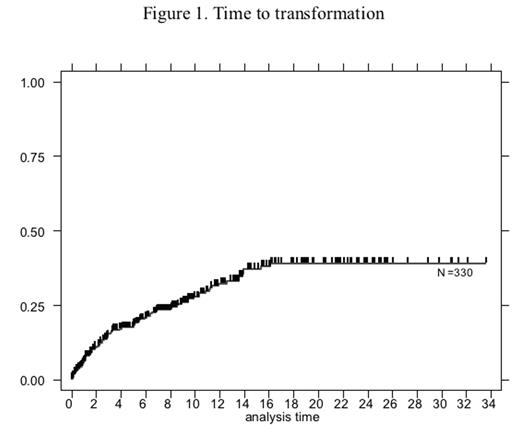Abstract
Between 1971 and 2000, 330 consecutive adults (176M/154F) with newly diagnosed FL were referred to St Bartholomew’s Hospital. The median age was 55 (range 23–90) years; 50 Stage I, 47 Stage II, 56 Stage III, 177 Stage IV. The FLIPI score was ‘low’: 38%, ‘intermediate’: 27%, ‘high’: 35%, with 111 missing observations (LDH or number of nodal sites). 100 patients are still alive, 230 having died between 6 months and 30 years, the causes of death being: disease 106, treatment-related complications 37, other malignancy 30, cardiac disease 20, ‘other’ 18, unknown 19. With expectant management if appropriate and intervention with irradiation, chemotherapy or immunotherapy at times of progression, the response rate was 84% at 1st treatment, declining to 43% at fifth, with duration of remission declining correspondingly. With a strict policy of documenting histology at each progression, a repeat biopsy rate of 70% was achieved. tFL has occurred in 89/330 cases between diagnosis and 16 years, in 25/330 (8%) whilst being managed expectantly or during first therapy and at a relatively constant rate at 2nd, 3rd, 4th and 5th progression, (17%, 16%, 15%, 14% respectively). To date, no patients have transformed after 16 years, with 41 patients ‘at risk’ between 16 and 35 years (Figure 1), 18 in continuous first remission and 23 having had a recurrence of FL. On univariate analysis, risk of transformation is higher with high FLIPI score (p= .009) and advanced stage (p= .02) at presentation. Survival of patients is shorter in whom transformation occurs (p= .0003). Median survival from transformation was 1.3 years, and correlated with ‘stage’ (p= .008) and LDH (p= .03) at the time of transformation, but not with time from diagnosis to transformation. These observations highlight the significance of transformation of FL to t-FL, demonstrating its major clinical importance. The actuarial prediction is that transformation will occur in at least 50% of patients overall with a very poor prognosis for the majority. The ‘time to transformation curve’ supports the hypothesis that there may be two distinct populations of patients who develop FL, one in which transformation is programmed to occur and one in which it is not.
Author notes
Corresponding author


This feature is available to Subscribers Only
Sign In or Create an Account Close Modal